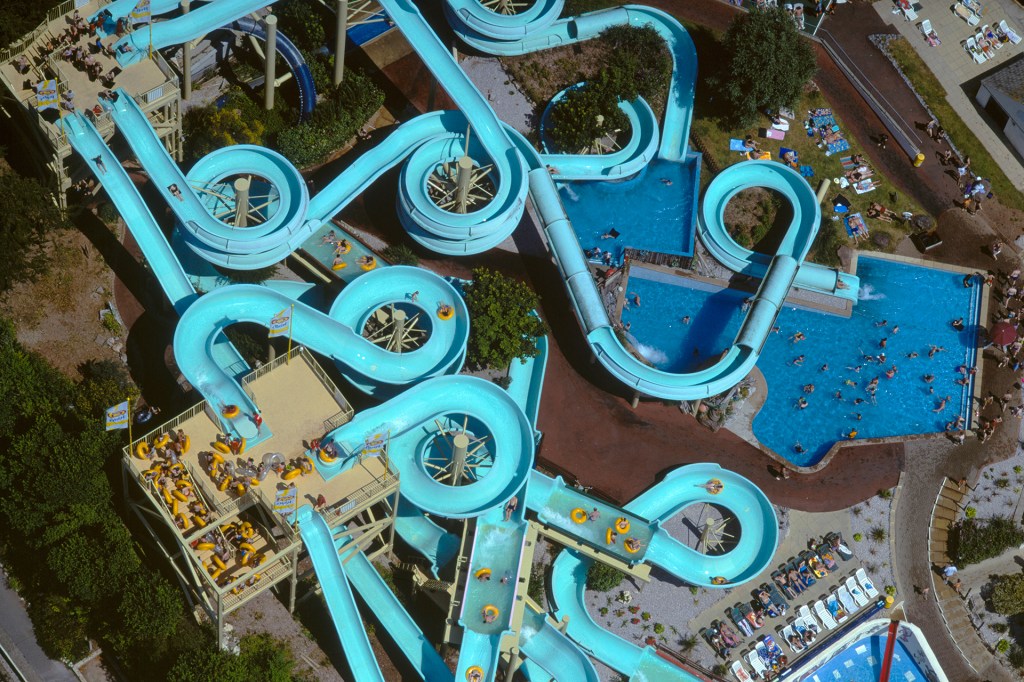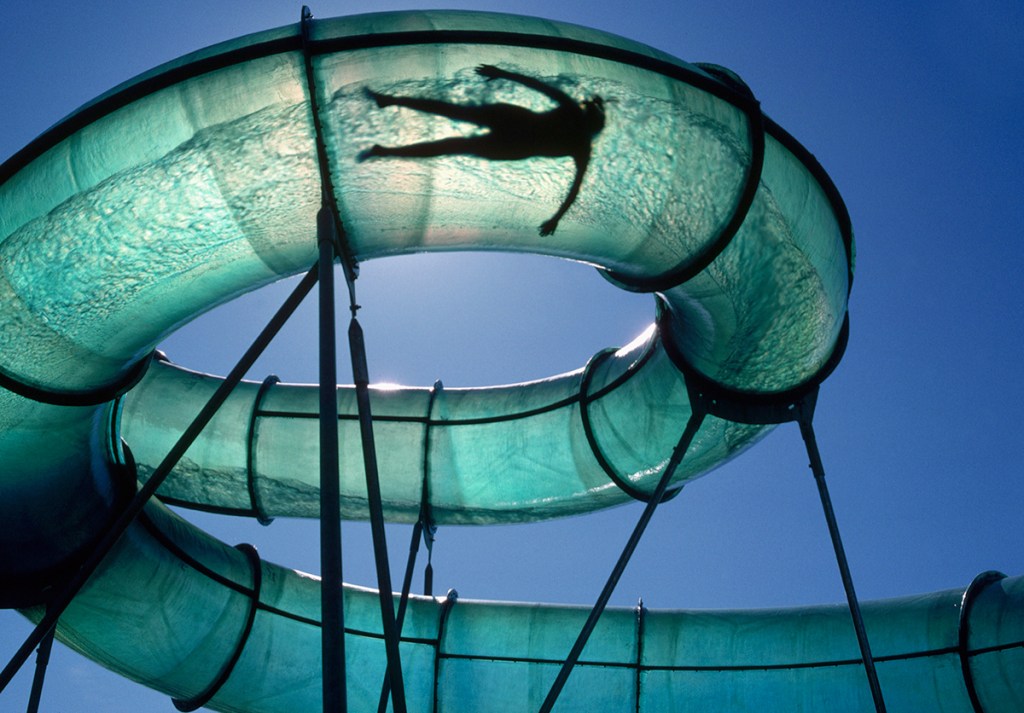The Science of Summer Fun

Walk up a set of stairs. Sit in a pool of rushing water, and look down at the slide before you. Push off—whoosh!—and let gravity take it from there.
This year, more than 85 million people around the world will visit water parks, according to the International Association of Amusement Parks. When they do, their rides will be guided by the laws of physics. That’s the branch of science that deals with the way objects move.
A Formula For Fun
Water-park physics begins with gravity. That’s the force that pulls objects to Earth. It’s also what waterslide designers rely on to get riders from the top of the slide to the bottom. Water helps move things along by creating a slippery layer between the rider and the slide.
To ensure a slide’s safety, designers consider many factors. These include the way water flows through it, riders’ potential size and weight, and the kinds of swimsuits they might be wearing.
Acceleration is what makes waterslides fun. It’s the scientific principle
principle
 KIDSTOCK/GETTY IMAGES
a law or rule
(noun)
The scientific principle of magnetism is what makes it possible for magnets to stick to your refrigerator.
used to describe what an object does when it changes speed or direction. In scientific terms, you accelerate not only when you speed up but also when you slow down or make a turn. Basically, all the best parts of a waterslide.
KIDSTOCK/GETTY IMAGES
a law or rule
(noun)
The scientific principle of magnetism is what makes it possible for magnets to stick to your refrigerator.
used to describe what an object does when it changes speed or direction. In scientific terms, you accelerate not only when you speed up but also when you slow down or make a turn. Basically, all the best parts of a waterslide.

SLIDE ON A rider sails around a curve on a waterslide in Utah.
SCOTT T. SMITH—GETTY IMAGES
“Acceleration is fun,” says Brian Jones, a physicist
physicist
 SANTI VISALLI/GETTY IMAGES
a scientist who studies matter and energy
(noun)
Stephen Hawking was a famous physicist who studied black holes.
at Colorado State University. But speed alone isn’t what makes a ride exciting. Consider this: On the average waterslide, riders splash along at 20 to 30 miles per hour. But the average airplane flies 600 miles per hour. That’s 20 times faster than a person travels on a waterslide. “Going fast isn’t interesting,” Jones says. “Otherwise, on airplanes people would be whooping and hollering and having a great time.”
SANTI VISALLI/GETTY IMAGES
a scientist who studies matter and energy
(noun)
Stephen Hawking was a famous physicist who studied black holes.
at Colorado State University. But speed alone isn’t what makes a ride exciting. Consider this: On the average waterslide, riders splash along at 20 to 30 miles per hour. But the average airplane flies 600 miles per hour. That’s 20 times faster than a person travels on a waterslide. “Going fast isn’t interesting,” Jones says. “Otherwise, on airplanes people would be whooping and hollering and having a great time.”
Waterslide designers zero in on two things to create acceleration. One is the slope of the slide, which affects a rider’s speed: The steeper the slide, the faster you go. Another is curves, which change a rider’s direction. Slopes and curves on a waterslide mean more acceleration. And more acceleration means more fun.
Some of the most thrilling slides also use slopes and curves to create something called a zero-g-force, or zero-gravity, moment. Designers plan a path that pushes a rider over a hump at the perfect rate of acceleration to create a feeling of weightlessness. “It’s that moment when you’re no longer going up and you haven’t started coming back down yet,” Ray Smegal told TFK. He’s in charge of waterslide design at a company in Canada called ProSlide Technology. “You literally feel like you’re hanging in zero gravity for about a second and a half.”
Imagine you’re on a swing at the playground. You know that instant at the top when the chain goes slack, and it feels like your stomach is in your chest? That’s a zero-g-force moment. You feel that way because your organs actually rise up inside your body. Normally, organs hang on pieces of tissue—think big rubber bands. Without gravity pulling on them, your organs shift upward. Astronauts in space experience this same shift.

MAKING PLANS A designer drafts plans for a new ProSlide ride.
COURTESY PROSLIDESlide Technology
In the last two decades, there have been major innovations
innovation
 CHOMBOSAN/ISTOCK/GETTY IMAGES
a new idea, device, or method
(noun)
Self-driving cars could be one of the most important innovations of the 21st century.
in waterslide technology. Designers are using 3D printing to make models of slides. The models show them how people will travel through a slide. “Emerging tools could change the way slides are created in the future,” Smegal says. Technology may lead to bigger and better rides. But slides will continue to rely on basic physics—and thrills—for years to come.
CHOMBOSAN/ISTOCK/GETTY IMAGES
a new idea, device, or method
(noun)
Self-driving cars could be one of the most important innovations of the 21st century.
in waterslide technology. Designers are using 3D printing to make models of slides. The models show them how people will travel through a slide. “Emerging tools could change the way slides are created in the future,” Smegal says. Technology may lead to bigger and better rides. But slides will continue to rely on basic physics—and thrills—for years to come.
Assessment: Click here for a printable quiz. Teacher subscribers can find the answer key in this week's Teacher's Guide.













